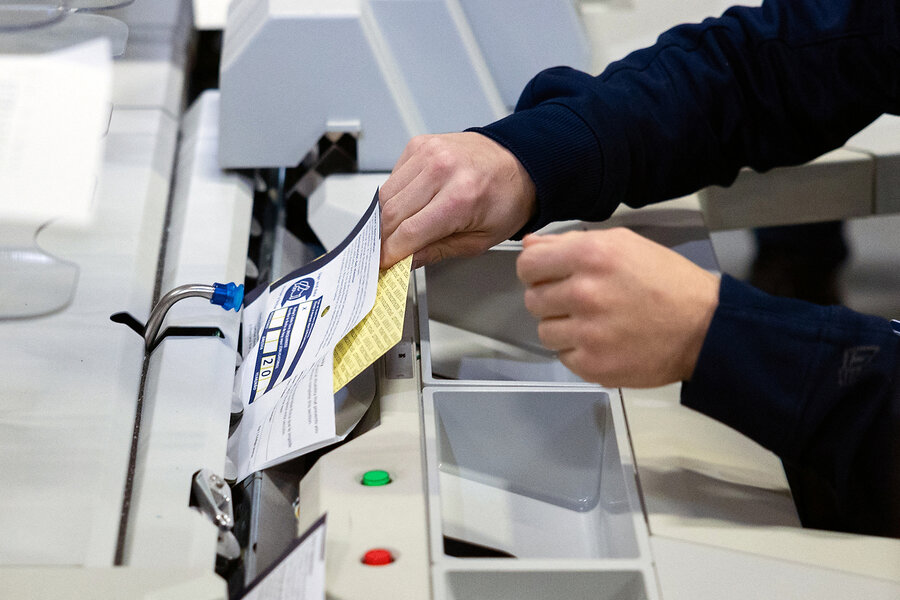
America’s election systems include safeguards – including for mail-in voting – to make sure that ballots are held securely and counted accurately, and that people can’t vote more than once. In Philadelphia, nonpartisan election staff review applications for mail-in ballots, and send a list of approved voters to a printing vendor. When voters have received and completed their ballot, they drop it off in person at an election office, return it in the mail, or leave it in one of 23 dropboxes monitored with 24/7 video surveillance.
Those ballots are then taken to a warehouse, registered and checked for mistakes, and timestamped and locked with other ballots in a large cage. At 7 a.m.
on Election Day, they are taken out of the cage and prepared for counting. Once ballots have been scanned, the Board of Elections posts the electronic results. Until results are certified, which requires a mandatory audit within 20 days of the election, the ballots are stored in a second cage, and a badge ID and code are required to access them.
After 22 months, the ballots are put in an acid bath, destroying any trace of them. Americans’ trust in the electoral process has fallen steeply in recent years, fueled in part by the fact that many don’t have a clear understanding of the steps involved in mailing, tracking, securing, and counting ballots. To that end, the Monitor took a closer look at the entire lifecycle of a ballot in Pennsylvania, one of the most contested states in the 2020 presidential election.
Though Pennsylvania’s legislature had adopted mail-in voting just prior to the pandemic, the state – particularly the Democratic stronghold of Philadelphia – became a focus of complaints from then-President Donald Trump and the GOP that a rapid scaling up of mail-in voting amid the pandemic made the election less secure. Mr. Trump brought dozens of lawsuits to bolster his claims that the election had been “stolen,” but none proved fraud.
Voting processes are highly localized in the United States. But examining the process in Philadelphia will give a sense of methods and procedures for securing ballots. This explainer is based on interviews with city commissioners, a tour of an election warehouse, and publicly available government information.
In Pennsylvania, any registered voter can apply for a mail-in ballot, without providing a specific reason why they want it. Nonpartisan election staff review these applications, and send a list of approved voters to a printing vendor, The Phoenix Group of Companies. The Phoenix Group prints a ballot for each greenlighted application.
When an application is approved and a ballot is mailed to a Pennsylvania voter, election workers enter a record of that ballot into a statewide database. Voters can track their ballots on the Department of State’s website , and find out when their application is processed, when the ballot is put in the mail to them, and when the voted ballot has been safely returned. Mail-in voters in Philadelphia County can drop it off in person at an election office, return it in the mail, or leave it in one of 23 dropboxes monitored with 24/7 video surveillance.
A County Board of Elections team daily picks up ballots and drives them in a city car to an election warehouse. Ballots that voters submitted at an election office are also driven to that warehouse daily, and the USPS delivers ballots returned in the mail directly there. At the warehouse, election staff check ballots for problems that could prevent them from being counted.
They put ballots through sorting equipment that measures their thickness to ensure they have a secrecy envelope, inside which voters are supposed to seal their ballot. The equipment also checks for a signature. Then, staff check the outer envelopes of ballots to make sure voters dated them with the date they filled out the ballot Each Pennsylvania county has its own rules about what to do when they find mistakes.
In Philadelphia, election officials will reach out directly to voters if they have their email on file. The county also posts a list of voters whose ballots had errors on their website. Sometimes political parties or campaigns check these websites and reach out to the voters directly.
If a voter finds out that their ballot had a mistake, they can try to fix it by sending in a replacement ballot or by filling out a provisional ballot on Election Day. Each ballot is tied to a specific barcode, which prevents a voter from voting twice. A provisional ballot is like a placeholder – it records the voter’s choice, and if counted would replace a voter’s defective mail-in ballot.
Once a mail-in ballot has been registered and checked for mistakes, clerks timestamp it and lock it with other ballots in a large cage until Election Day. Only clerk supervisors can unlock them, which requires their badge ID and an access code. Election staff count mail-in ballots in the warehouse on election day, and a mandatory post-election audit takes place here afterwards.
Fences and camera surveillance protect it year-round, and when ballots start coming in, security guards are brought in. In Philadelphia, poll workers look voters up by name in poll books as they come in, and check that they’re in the right precinct and haven’t already voted by mail. First-time voters in the precinct have to show identification , though this doesn’t have to be a photo ID.
Voters fill out ballots privately, and submit them into an ExpressVote XL voting machine. The machine will detect problems with ballots – say, if the voter selected two different presidential candidates – and alert the voter. When polls close at 8 p.
m., teams from the Philadelphia Police Department pick up ballots from polling places. An election judge, who oversees operations at a polling place, will have prepared two bags for the police teams – one large sack containing the ballot bags from each voting machine, sealed with a string, and a smaller zippered vinyl bag with the USB sticks that store the voting machines’ electronic records.
The judge waits at the polling place until the police arrive. Each team of police will pick up ballots from several polling places and drive them back to the election warehouse. Meanwhile, election staff will have taken mail-in ballots out of their cages in the warehouse at 7 a.
m. Around 150 election workers – a blend of temporary staff, full-time civil servants, and voting machine vendors – start the process of preparing these ballots for counting. In one cluster of desks, staff scan outer envelopes for any mistakes that weren’t caught before, and then put them through an extractor that slices open the tops of the envelopes, revealing the secrecy envelopes inside.
After repeating this process for a tray of ballots, election staff walk the bundle of secrecy envelopes down to a separate set of tables a few steps away, where they are similarly sliced open. The reason the secrecy envelopes are moved is to make sure that no staff member can see both the outer envelope, which has the voter’s identifying information on it, and the corresponding ballot. Finally, staff flatten the ballots by hand, and scan them through the same voting machines that are used in polling places.
If a voting machine detects a problem with a mail-in ballot, it’s up to full-time election staff to decide whether it can be counted. Their decisions, along with a photo of the ballot, are displayed on a screen so that poll watchers – representatives of a political party or candidate who are authorized to observe the election process – can observe how the decision was made. If they disagree with a decision, they can bring a challenge to the election judge.
Once ballots have been scanned, the Board of Elections posts the electronic results – the results on the machines’ SD cards – in batches on their website. Until election results are certified, the ballots are stored in a second cage. Accessing that cage also requires a badge ID and a code.
Before certification, the ballots go through a mandatory audit within 20 days of the election. That consists of county employees counting a random sample of ballots by hand and making sure their total matches the electronic results. Once the audit is done, the Board of Elections sends these results to the Department of State to be certified.
After certification, ballots are moved to a back room in the warehouse and stored for 22 months, according to federal law. Then the ballots are put in an acid bath, destroying any trace of them..














